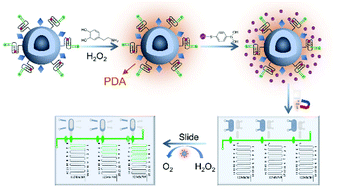Aptazyme-induced cascade amplification integrated with a volumetric bar-chart chip for highly sensitive detection of aflatoxin B1 and adenosine triphosphate†
Abstract
A simple aptazyme-induced cascade signal amplification (denoted as ACSA) was integrated with a triple-channel volumetric bar-chart chip (TV-Chip) to visually quantitate aflatoxin B1 (AFB1) and adenosine triphosphate (ATP). Bifunctional aptazymes consisting of aptamers and G-quadruplex-forming sequences were modified on magnetic silica nanoparticles (MSNPs) to construct sensing probes. The recognition of aptamers and targets leads to the formation of hemin/G-quadruplex (hGQ) DNAzymes, which can mimic the horseradish peroxidase (HRP)-accelerated signal enhancement reaction, enabling the polymerization of dopamine and subsequent deposition of polydopamine (PDA) on the MSNP probes, thereby providing abundant anchor sites to covalently immobilize numerous 4-mercaptophenylboric acid (4-MPBA)-modified platinum nanoparticles (PtNPs) (MPt). As a result, this strategy possesses high sensitivity by introducing a large number of PtNPs into the TV-Chip. The detection limits of AFB1 and ATP with 0.075 pM and 0.818 pM, respectively, were easily achieved without any additional instruments. In addition, the detection results of AFB1-spiked food samples were in good agreement with the commercial AFB1 ELISA kit, which verified the accuracy and reliability of this method. The ACSA-based TV-Chip would show great promise for on-site and real-time visual quantitation of trace targets.



 Please wait while we load your content...
Please wait while we load your content...